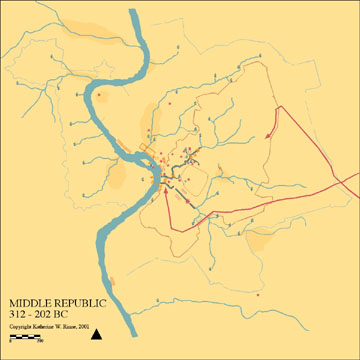Output Choices:
- Large JPEG
- X3D
(For X3D plug-in information click here.)
You have chosen to view:

Output Choices:
|
You have chosen to view: |
Click here to view Map Legend
The Middle Republican period was a time of great innovation in the water infrastructure of Rome. In 312 BC the first aqueduct, the Aqua Appia, was built in order to bring fresh water supplies to the City. Rome had experienced tremendous growth during the Early Republican period and was in desperate need of new water sources. The Aqua Appia terminated near the busy and congested port area - in the Velabrum. Fifty years later, in 273 BC another aqueduct, the Aqua Anio Vetus, was built to bring water to the Esquiline hill. Although the technology employed was rather conservative, together these aqeuducts revolutionized the water infrastructure of Rome. They are the ancestors of an aqueduct systems that is still functioning today. It was during this period that we have the first clear references to the use of the Tiber Island. A healing place, dedicated to the cult of Aesculapius, was established on the island in 292 BC at the site of a natural spring.
To learn about any feature, open the map in JPEG, then click on the feature. This will link to an inventory entry with descriptive text, images, historic texts, archival maps and images, and to a bibliography. The complete inventory for most features is still under construction.